AHMI1643 Mechanical Engineering: Assessment 1 - Questioning Analysis
VerifiedAdded on 2023/01/13
|22
|5536
|21
Homework Assignment
AI Summary
This document contains a completed written assessment for a mechanical engineering unit, focusing on the analysis of engine and fuel system faults. The assessment covers various aspects, including personal protection equipment, safety precautions when working around engines and cooling systems, handling of engine oil and coolant, and waste disposal methods. It includes true/false questions on diesel fuel and diagnostic charts, as well as multiple-choice questions on diagnostic approaches. The student's responses demonstrate an understanding of the safety protocols, diagnostic procedures, and the importance of critical thinking in identifying and addressing engine and fuel system issues. The assignment is an open-book assessment, requiring the student to answer questions in their own words. The assessment also covers topics such as flammable liquids and the use of safety data sheets. The student's work is evaluated based on the elements, performance criteria, performance evidence, and knowledge evidence relevant to the unit of competency.
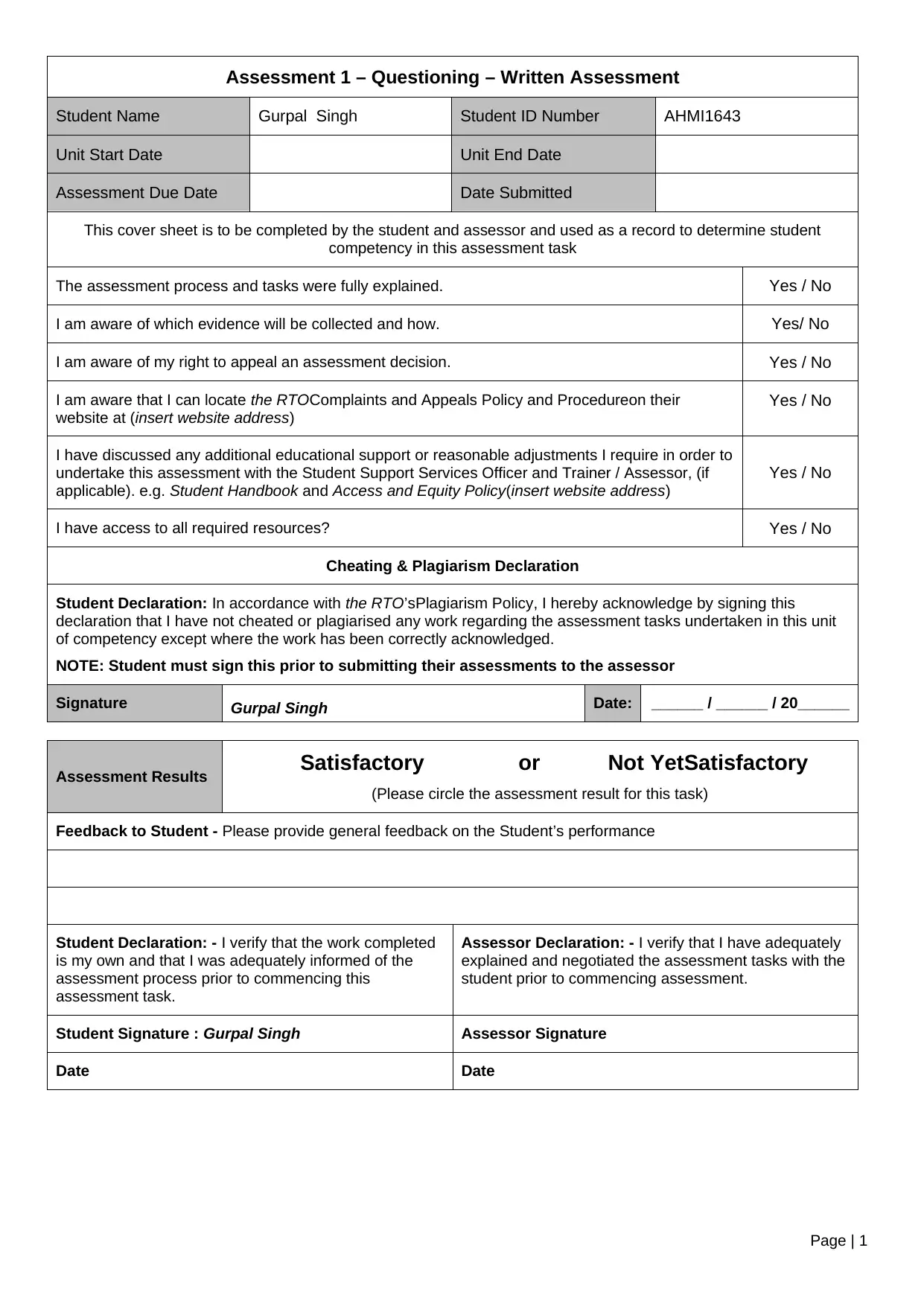
Assessment 1 – Questioning – Written Assessment
Student Name Gurpal Singh Student ID Number AHMI1643
Unit Start Date Unit End Date
Assessment Due Date Date Submitted
This cover sheet is to be completed by the student and assessor and used as a record to determine student
competency in this assessment task
The assessment process and tasks were fully explained. Yes / No
I am aware of which evidence will be collected and how. Yes/ No
I am aware of my right to appeal an assessment decision. Yes / No
I am aware that I can locate the RTOComplaints and Appeals Policy and Procedureon their
website at (insert website address)
Yes / No
I have discussed any additional educational support or reasonable adjustments I require in order to
undertake this assessment with the Student Support Services Officer and Trainer / Assessor, (if
applicable). e.g. Student Handbook and Access and Equity Policy(insert website address)
Yes / No
I have access to all required resources? Yes / No
Cheating & Plagiarism Declaration
Student Declaration: In accordance with the RTO’sPlagiarism Policy, I hereby acknowledge by signing this
declaration that I have not cheated or plagiarised any work regarding the assessment tasks undertaken in this unit
of competency except where the work has been correctly acknowledged.
NOTE: Student must sign this prior to submitting their assessments to the assessor
Signature Gurpal Singh Date: ______ / ______ / 20______
Assessment Results Satisfactory or Not YetSatisfactory
(Please circle the assessment result for this task)
Feedback to Student - Please provide general feedback on the Student’s performance
Student Declaration: - I verify that the work completed
is my own and that I was adequately informed of the
assessment process prior to commencing this
assessment task.
Assessor Declaration: - I verify that I have adequately
explained and negotiated the assessment tasks with the
student prior to commencing assessment.
Student Signature : Gurpal Singh Assessor Signature
Date Date
Page | 1
Student Name Gurpal Singh Student ID Number AHMI1643
Unit Start Date Unit End Date
Assessment Due Date Date Submitted
This cover sheet is to be completed by the student and assessor and used as a record to determine student
competency in this assessment task
The assessment process and tasks were fully explained. Yes / No
I am aware of which evidence will be collected and how. Yes/ No
I am aware of my right to appeal an assessment decision. Yes / No
I am aware that I can locate the RTOComplaints and Appeals Policy and Procedureon their
website at (insert website address)
Yes / No
I have discussed any additional educational support or reasonable adjustments I require in order to
undertake this assessment with the Student Support Services Officer and Trainer / Assessor, (if
applicable). e.g. Student Handbook and Access and Equity Policy(insert website address)
Yes / No
I have access to all required resources? Yes / No
Cheating & Plagiarism Declaration
Student Declaration: In accordance with the RTO’sPlagiarism Policy, I hereby acknowledge by signing this
declaration that I have not cheated or plagiarised any work regarding the assessment tasks undertaken in this unit
of competency except where the work has been correctly acknowledged.
NOTE: Student must sign this prior to submitting their assessments to the assessor
Signature Gurpal Singh Date: ______ / ______ / 20______
Assessment Results Satisfactory or Not YetSatisfactory
(Please circle the assessment result for this task)
Feedback to Student - Please provide general feedback on the Student’s performance
Student Declaration: - I verify that the work completed
is my own and that I was adequately informed of the
assessment process prior to commencing this
assessment task.
Assessor Declaration: - I verify that I have adequately
explained and negotiated the assessment tasks with the
student prior to commencing assessment.
Student Signature : Gurpal Singh Assessor Signature
Date Date
Page | 1
Paraphrase This Document
Need a fresh take? Get an instant paraphrase of this document with our AI Paraphraser
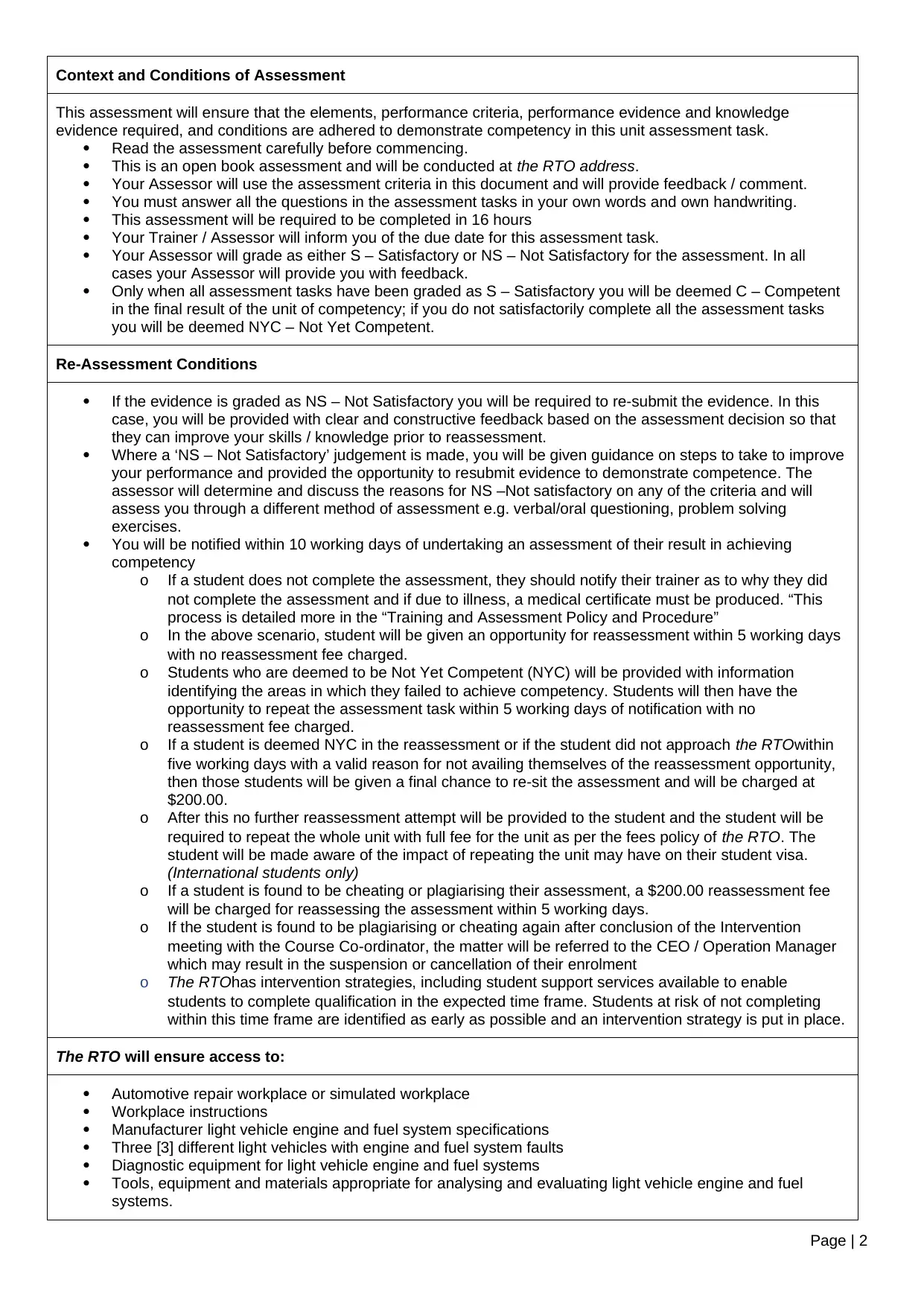
Context and Conditions of Assessment
This assessment will ensure that the elements, performance criteria, performance evidence and knowledge
evidence required, and conditions are adhered to demonstrate competency in this unit assessment task.
Read the assessment carefully before commencing.
This is an open book assessment and will be conducted at the RTO address.
Your Assessor will use the assessment criteria in this document and will provide feedback / comment.
You must answer all the questions in the assessment tasks in your own words and own handwriting.
This assessment will be required to be completed in 16 hours
Your Trainer / Assessor will inform you of the due date for this assessment task.
Your Assessor will grade as either S – Satisfactory or NS – Not Satisfactory for the assessment. In all
cases your Assessor will provide you with feedback.
Only when all assessment tasks have been graded as S – Satisfactory you will be deemed C – Competent
in the final result of the unit of competency; if you do not satisfactorily complete all the assessment tasks
you will be deemed NYC – Not Yet Competent.
Re-Assessment Conditions
If the evidence is graded as NS – Not Satisfactory you will be required to re-submit the evidence. In this
case, you will be provided with clear and constructive feedback based on the assessment decision so that
they can improve your skills / knowledge prior to reassessment.
Where a ‘NS – Not Satisfactory’ judgement is made, you will be given guidance on steps to take to improve
your performance and provided the opportunity to resubmit evidence to demonstrate competence. The
assessor will determine and discuss the reasons for NS –Not satisfactory on any of the criteria and will
assess you through a different method of assessment e.g. verbal/oral questioning, problem solving
exercises.
You will be notified within 10 working days of undertaking an assessment of their result in achieving
competency
o If a student does not complete the assessment, they should notify their trainer as to why they did
not complete the assessment and if due to illness, a medical certificate must be produced. “This
process is detailed more in the “Training and Assessment Policy and Procedure”
o In the above scenario, student will be given an opportunity for reassessment within 5 working days
with no reassessment fee charged.
o Students who are deemed to be Not Yet Competent (NYC) will be provided with information
identifying the areas in which they failed to achieve competency. Students will then have the
opportunity to repeat the assessment task within 5 working days of notification with no
reassessment fee charged.
o If a student is deemed NYC in the reassessment or if the student did not approach the RTOwithin
five working days with a valid reason for not availing themselves of the reassessment opportunity,
then those students will be given a final chance to re-sit the assessment and will be charged at
$200.00.
o After this no further reassessment attempt will be provided to the student and the student will be
required to repeat the whole unit with full fee for the unit as per the fees policy of the RTO. The
student will be made aware of the impact of repeating the unit may have on their student visa.
(International students only)
o If a student is found to be cheating or plagiarising their assessment, a $200.00 reassessment fee
will be charged for reassessing the assessment within 5 working days.
o If the student is found to be plagiarising or cheating again after conclusion of the Intervention
meeting with the Course Co-ordinator, the matter will be referred to the CEO / Operation Manager
which may result in the suspension or cancellation of their enrolment
o The RTOhas intervention strategies, including student support services available to enable
students to complete qualification in the expected time frame. Students at risk of not completing
within this time frame are identified as early as possible and an intervention strategy is put in place.
The RTO will ensure access to:
Automotive repair workplace or simulated workplace
Workplace instructions
Manufacturer light vehicle engine and fuel system specifications
Three [3] different light vehicles with engine and fuel system faults
Diagnostic equipment for light vehicle engine and fuel systems
Tools, equipment and materials appropriate for analysing and evaluating light vehicle engine and fuel
systems.
Page | 2
This assessment will ensure that the elements, performance criteria, performance evidence and knowledge
evidence required, and conditions are adhered to demonstrate competency in this unit assessment task.
Read the assessment carefully before commencing.
This is an open book assessment and will be conducted at the RTO address.
Your Assessor will use the assessment criteria in this document and will provide feedback / comment.
You must answer all the questions in the assessment tasks in your own words and own handwriting.
This assessment will be required to be completed in 16 hours
Your Trainer / Assessor will inform you of the due date for this assessment task.
Your Assessor will grade as either S – Satisfactory or NS – Not Satisfactory for the assessment. In all
cases your Assessor will provide you with feedback.
Only when all assessment tasks have been graded as S – Satisfactory you will be deemed C – Competent
in the final result of the unit of competency; if you do not satisfactorily complete all the assessment tasks
you will be deemed NYC – Not Yet Competent.
Re-Assessment Conditions
If the evidence is graded as NS – Not Satisfactory you will be required to re-submit the evidence. In this
case, you will be provided with clear and constructive feedback based on the assessment decision so that
they can improve your skills / knowledge prior to reassessment.
Where a ‘NS – Not Satisfactory’ judgement is made, you will be given guidance on steps to take to improve
your performance and provided the opportunity to resubmit evidence to demonstrate competence. The
assessor will determine and discuss the reasons for NS –Not satisfactory on any of the criteria and will
assess you through a different method of assessment e.g. verbal/oral questioning, problem solving
exercises.
You will be notified within 10 working days of undertaking an assessment of their result in achieving
competency
o If a student does not complete the assessment, they should notify their trainer as to why they did
not complete the assessment and if due to illness, a medical certificate must be produced. “This
process is detailed more in the “Training and Assessment Policy and Procedure”
o In the above scenario, student will be given an opportunity for reassessment within 5 working days
with no reassessment fee charged.
o Students who are deemed to be Not Yet Competent (NYC) will be provided with information
identifying the areas in which they failed to achieve competency. Students will then have the
opportunity to repeat the assessment task within 5 working days of notification with no
reassessment fee charged.
o If a student is deemed NYC in the reassessment or if the student did not approach the RTOwithin
five working days with a valid reason for not availing themselves of the reassessment opportunity,
then those students will be given a final chance to re-sit the assessment and will be charged at
$200.00.
o After this no further reassessment attempt will be provided to the student and the student will be
required to repeat the whole unit with full fee for the unit as per the fees policy of the RTO. The
student will be made aware of the impact of repeating the unit may have on their student visa.
(International students only)
o If a student is found to be cheating or plagiarising their assessment, a $200.00 reassessment fee
will be charged for reassessing the assessment within 5 working days.
o If the student is found to be plagiarising or cheating again after conclusion of the Intervention
meeting with the Course Co-ordinator, the matter will be referred to the CEO / Operation Manager
which may result in the suspension or cancellation of their enrolment
o The RTOhas intervention strategies, including student support services available to enable
students to complete qualification in the expected time frame. Students at risk of not completing
within this time frame are identified as early as possible and an intervention strategy is put in place.
The RTO will ensure access to:
Automotive repair workplace or simulated workplace
Workplace instructions
Manufacturer light vehicle engine and fuel system specifications
Three [3] different light vehicles with engine and fuel system faults
Diagnostic equipment for light vehicle engine and fuel systems
Tools, equipment and materials appropriate for analysing and evaluating light vehicle engine and fuel
systems.
Page | 2
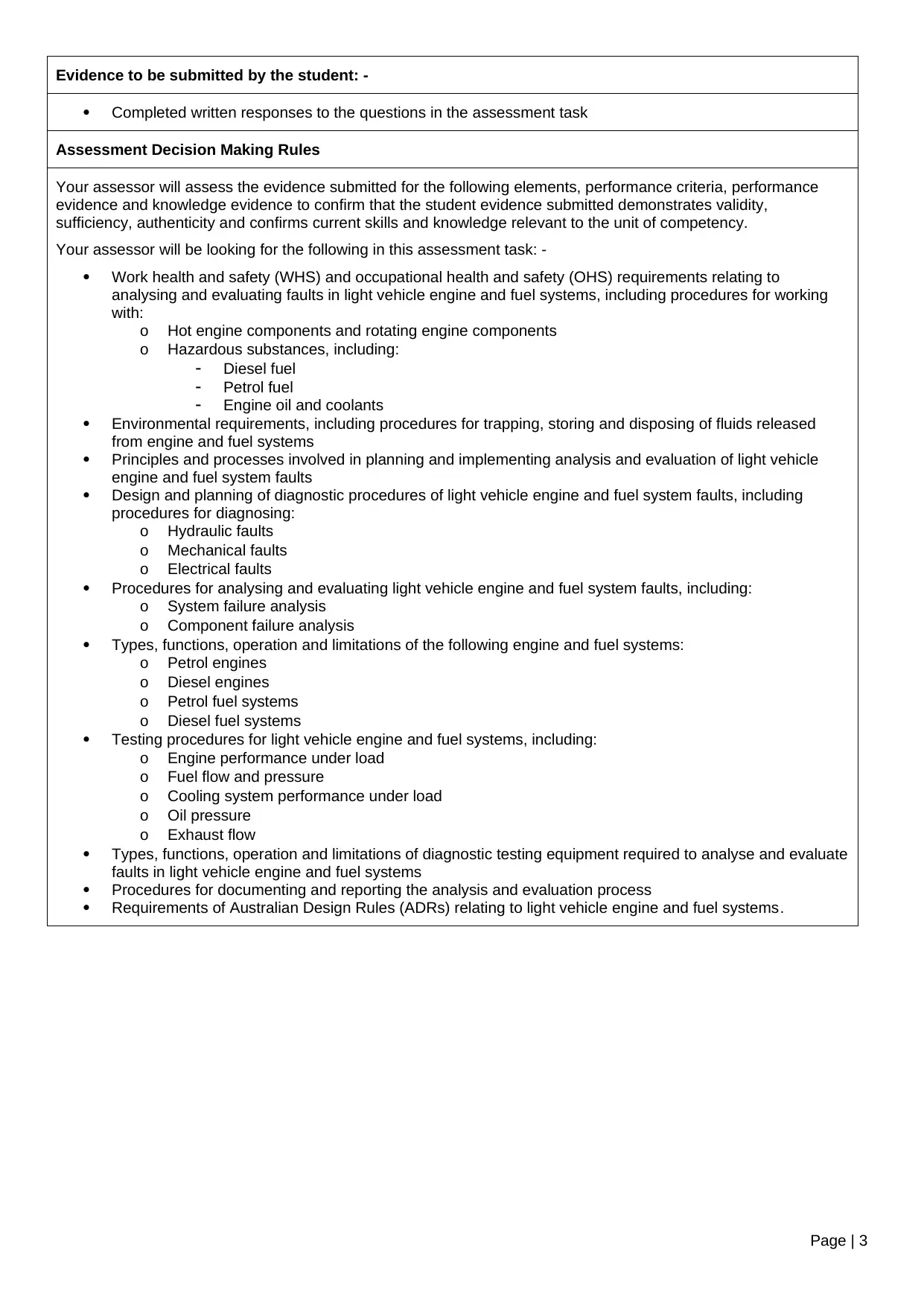
Evidence to be submitted by the student: -
Completed written responses to the questions in the assessment task
Assessment Decision Making Rules
Your assessor will assess the evidence submitted for the following elements, performance criteria, performance
evidence and knowledge evidence to confirm that the student evidence submitted demonstrates validity,
sufficiency, authenticity and confirms current skills and knowledge relevant to the unit of competency.
Your assessor will be looking for the following in this assessment task: -
Work health and safety (WHS) and occupational health and safety (OHS) requirements relating to
analysing and evaluating faults in light vehicle engine and fuel systems, including procedures for working
with:
o Hot engine components and rotating engine components
o Hazardous substances, including:
Diesel fuel
Petrol fuel
Engine oil and coolants
Environmental requirements, including procedures for trapping, storing and disposing of fluids released
from engine and fuel systems
Principles and processes involved in planning and implementing analysis and evaluation of light vehicle
engine and fuel system faults
Design and planning of diagnostic procedures of light vehicle engine and fuel system faults, including
procedures for diagnosing:
o Hydraulic faults
o Mechanical faults
o Electrical faults
Procedures for analysing and evaluating light vehicle engine and fuel system faults, including:
o System failure analysis
o Component failure analysis
Types, functions, operation and limitations of the following engine and fuel systems:
o Petrol engines
o Diesel engines
o Petrol fuel systems
o Diesel fuel systems
Testing procedures for light vehicle engine and fuel systems, including:
o Engine performance under load
o Fuel flow and pressure
o Cooling system performance under load
o Oil pressure
o Exhaust flow
Types, functions, operation and limitations of diagnostic testing equipment required to analyse and evaluate
faults in light vehicle engine and fuel systems
Procedures for documenting and reporting the analysis and evaluation process
Requirements of Australian Design Rules (ADRs) relating to light vehicle engine and fuel systems.
Page | 3
Completed written responses to the questions in the assessment task
Assessment Decision Making Rules
Your assessor will assess the evidence submitted for the following elements, performance criteria, performance
evidence and knowledge evidence to confirm that the student evidence submitted demonstrates validity,
sufficiency, authenticity and confirms current skills and knowledge relevant to the unit of competency.
Your assessor will be looking for the following in this assessment task: -
Work health and safety (WHS) and occupational health and safety (OHS) requirements relating to
analysing and evaluating faults in light vehicle engine and fuel systems, including procedures for working
with:
o Hot engine components and rotating engine components
o Hazardous substances, including:
Diesel fuel
Petrol fuel
Engine oil and coolants
Environmental requirements, including procedures for trapping, storing and disposing of fluids released
from engine and fuel systems
Principles and processes involved in planning and implementing analysis and evaluation of light vehicle
engine and fuel system faults
Design and planning of diagnostic procedures of light vehicle engine and fuel system faults, including
procedures for diagnosing:
o Hydraulic faults
o Mechanical faults
o Electrical faults
Procedures for analysing and evaluating light vehicle engine and fuel system faults, including:
o System failure analysis
o Component failure analysis
Types, functions, operation and limitations of the following engine and fuel systems:
o Petrol engines
o Diesel engines
o Petrol fuel systems
o Diesel fuel systems
Testing procedures for light vehicle engine and fuel systems, including:
o Engine performance under load
o Fuel flow and pressure
o Cooling system performance under load
o Oil pressure
o Exhaust flow
Types, functions, operation and limitations of diagnostic testing equipment required to analyse and evaluate
faults in light vehicle engine and fuel systems
Procedures for documenting and reporting the analysis and evaluation process
Requirements of Australian Design Rules (ADRs) relating to light vehicle engine and fuel systems.
Page | 3
⊘ This is a preview!⊘
Do you want full access?
Subscribe today to unlock all pages.

Trusted by 1+ million students worldwide
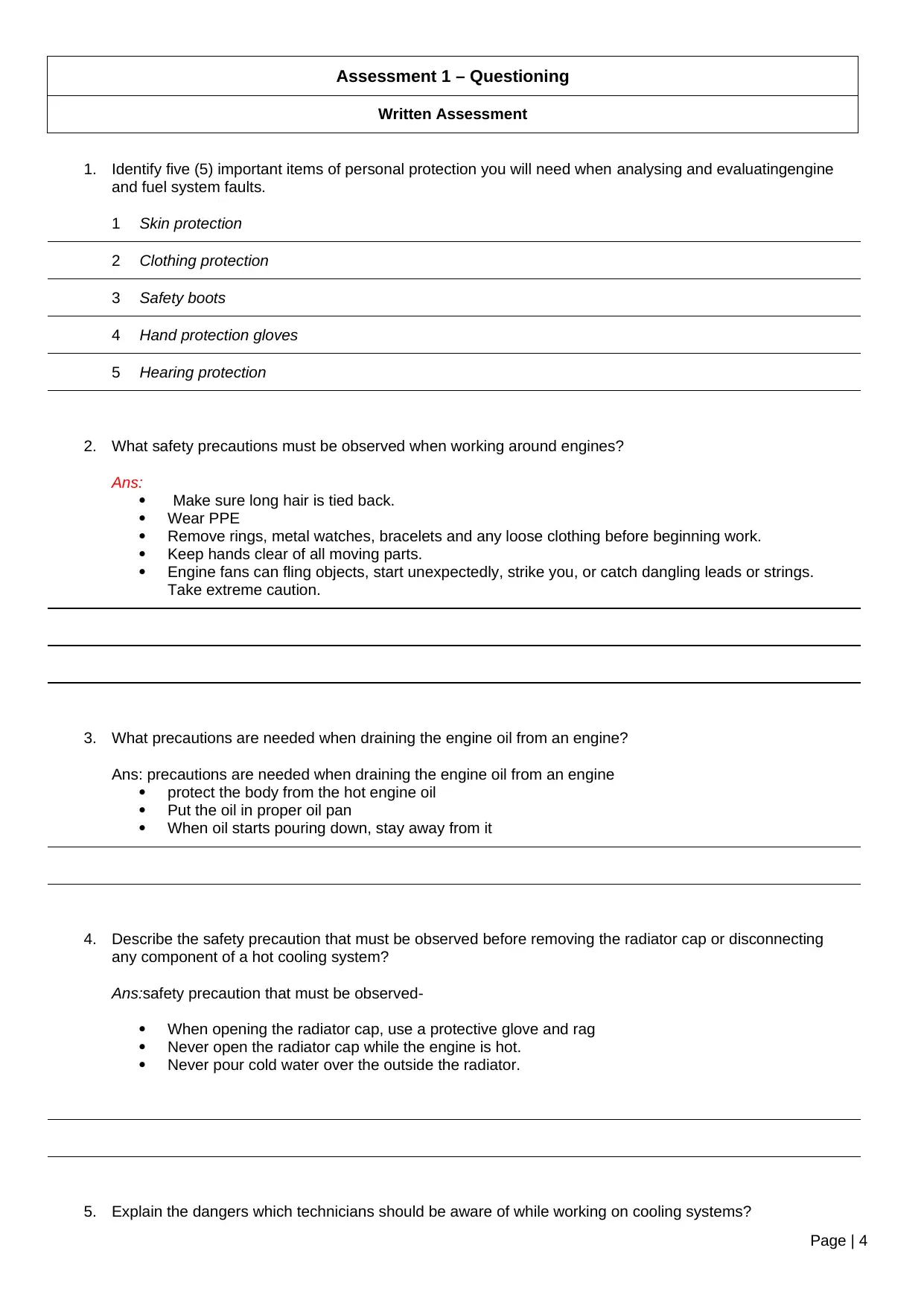
Assessment 1 – Questioning
Written Assessment
1. Identify five (5) important items of personal protection you will need when analysing and evaluatingengine
and fuel system faults.
1 Skin protection
2 Clothing protection
3 Safety boots
4 Hand protection gloves
5 Hearing protection
2. What safety precautions must be observed when working around engines?
Ans:
“Make sure long hair is tied back.
Wear PPE
Remove rings, metal watches, bracelets and any loose clothing before beginning work.
Keep hands clear of all moving parts.
Engine fans can fling objects, start unexpectedly, strike you, or catch dangling leads or strings.
Take extreme caution.””
3. What precautions are needed when draining the engine oil from an engine?
Ans: precautions are needed when draining the engine oil from an engine
protect the body from the hot engine oil
Put the oil in proper oil pan
When oil starts pouring down, stay away from it
4. Describe the safety precaution that must be observed before removing the radiator cap or disconnecting
any component of a hot cooling system?
Ans:safety precaution that must be observed-
When opening the radiator cap, use a protective glove and rag”
Never open the radiator cap while the engine is hot.
Never pour cold water over the outside the radiator.
5. Explain the dangers which technicians should be aware of while working on cooling systems?
Page | 4
Written Assessment
1. Identify five (5) important items of personal protection you will need when analysing and evaluatingengine
and fuel system faults.
1 Skin protection
2 Clothing protection
3 Safety boots
4 Hand protection gloves
5 Hearing protection
2. What safety precautions must be observed when working around engines?
Ans:
“Make sure long hair is tied back.
Wear PPE
Remove rings, metal watches, bracelets and any loose clothing before beginning work.
Keep hands clear of all moving parts.
Engine fans can fling objects, start unexpectedly, strike you, or catch dangling leads or strings.
Take extreme caution.””
3. What precautions are needed when draining the engine oil from an engine?
Ans: precautions are needed when draining the engine oil from an engine
protect the body from the hot engine oil
Put the oil in proper oil pan
When oil starts pouring down, stay away from it
4. Describe the safety precaution that must be observed before removing the radiator cap or disconnecting
any component of a hot cooling system?
Ans:safety precaution that must be observed-
When opening the radiator cap, use a protective glove and rag”
Never open the radiator cap while the engine is hot.
Never pour cold water over the outside the radiator.
5. Explain the dangers which technicians should be aware of while working on cooling systems?
Page | 4
Paraphrase This Document
Need a fresh take? Get an instant paraphrase of this document with our AI Paraphraser
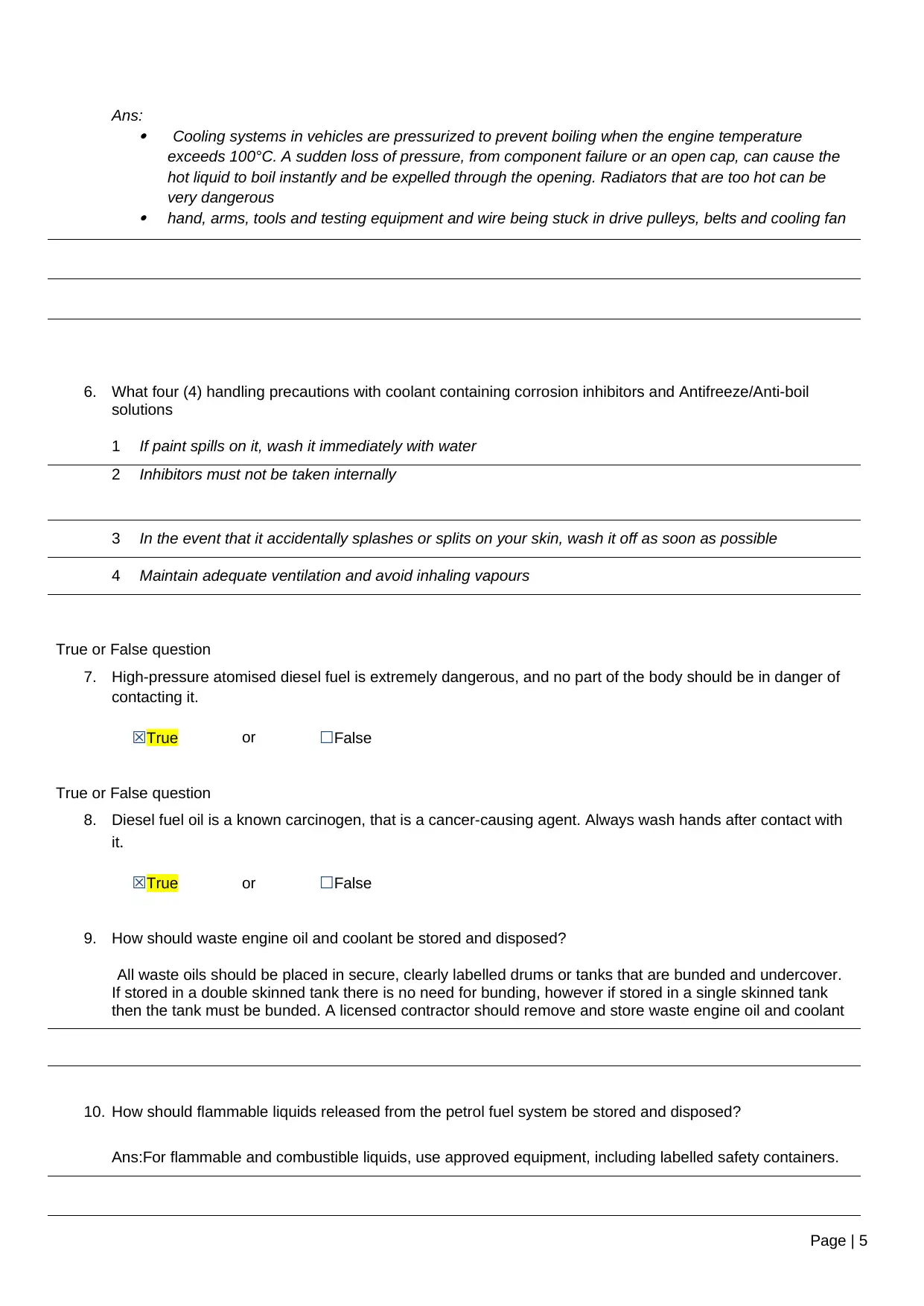
Ans:
“Cooling systems in vehicles are pressurized to prevent boiling when the engine temperature
exceeds 100°C. A sudden loss of pressure, from component failure or an open cap, can cause the
hot liquid to boil instantly and be expelled through the opening. Radiators that are too hot can be
very dangerous
hand, arms, tools and testing equipment and wire being stuck in drive pulleys, belts and cooling fan”
6. What four (4) handling precautions with coolant containing corrosion inhibitors and Antifreeze/Anti-boil
solutions
1 If paint spills on it, wash it immediately with water
2 Inhibitors must not be taken internally
3 In the event that it accidentally splashes or splits on your skin, wash it off as soon as possible
4 Maintain adequate ventilation and avoid inhaling vapours
True or False question
7. High-pressure atomised diesel fuel is extremely dangerous, and no part of the body should be in danger of
contacting it.
☒True or ☐False
True or False question
8. Diesel fuel oil is a known carcinogen, that is a cancer-causing agent. Always wash hands after contact with
it.
☒True or ☐False
9. How should waste engine oil and coolant be stored and disposed?
“All waste oils should be placed in secure, clearly labelled drums or tanks that are bunded and undercover.
If stored in a double skinned tank there is no need for bunding, however if stored in a single skinned tank
then the tank must be bunded. A licensed contractor should remove and store waste engine oil and coolant
10. How should flammable liquids released from the petrol fuel system be stored and disposed?
Ans:For flammable and combustible liquids, use approved equipment, including labelled safety containers.
Page | 5
“Cooling systems in vehicles are pressurized to prevent boiling when the engine temperature
exceeds 100°C. A sudden loss of pressure, from component failure or an open cap, can cause the
hot liquid to boil instantly and be expelled through the opening. Radiators that are too hot can be
very dangerous
hand, arms, tools and testing equipment and wire being stuck in drive pulleys, belts and cooling fan”
6. What four (4) handling precautions with coolant containing corrosion inhibitors and Antifreeze/Anti-boil
solutions
1 If paint spills on it, wash it immediately with water
2 Inhibitors must not be taken internally
3 In the event that it accidentally splashes or splits on your skin, wash it off as soon as possible
4 Maintain adequate ventilation and avoid inhaling vapours
True or False question
7. High-pressure atomised diesel fuel is extremely dangerous, and no part of the body should be in danger of
contacting it.
☒True or ☐False
True or False question
8. Diesel fuel oil is a known carcinogen, that is a cancer-causing agent. Always wash hands after contact with
it.
☒True or ☐False
9. How should waste engine oil and coolant be stored and disposed?
“All waste oils should be placed in secure, clearly labelled drums or tanks that are bunded and undercover.
If stored in a double skinned tank there is no need for bunding, however if stored in a single skinned tank
then the tank must be bunded. A licensed contractor should remove and store waste engine oil and coolant
10. How should flammable liquids released from the petrol fuel system be stored and disposed?
Ans:For flammable and combustible liquids, use approved equipment, including labelled safety containers.
Page | 5
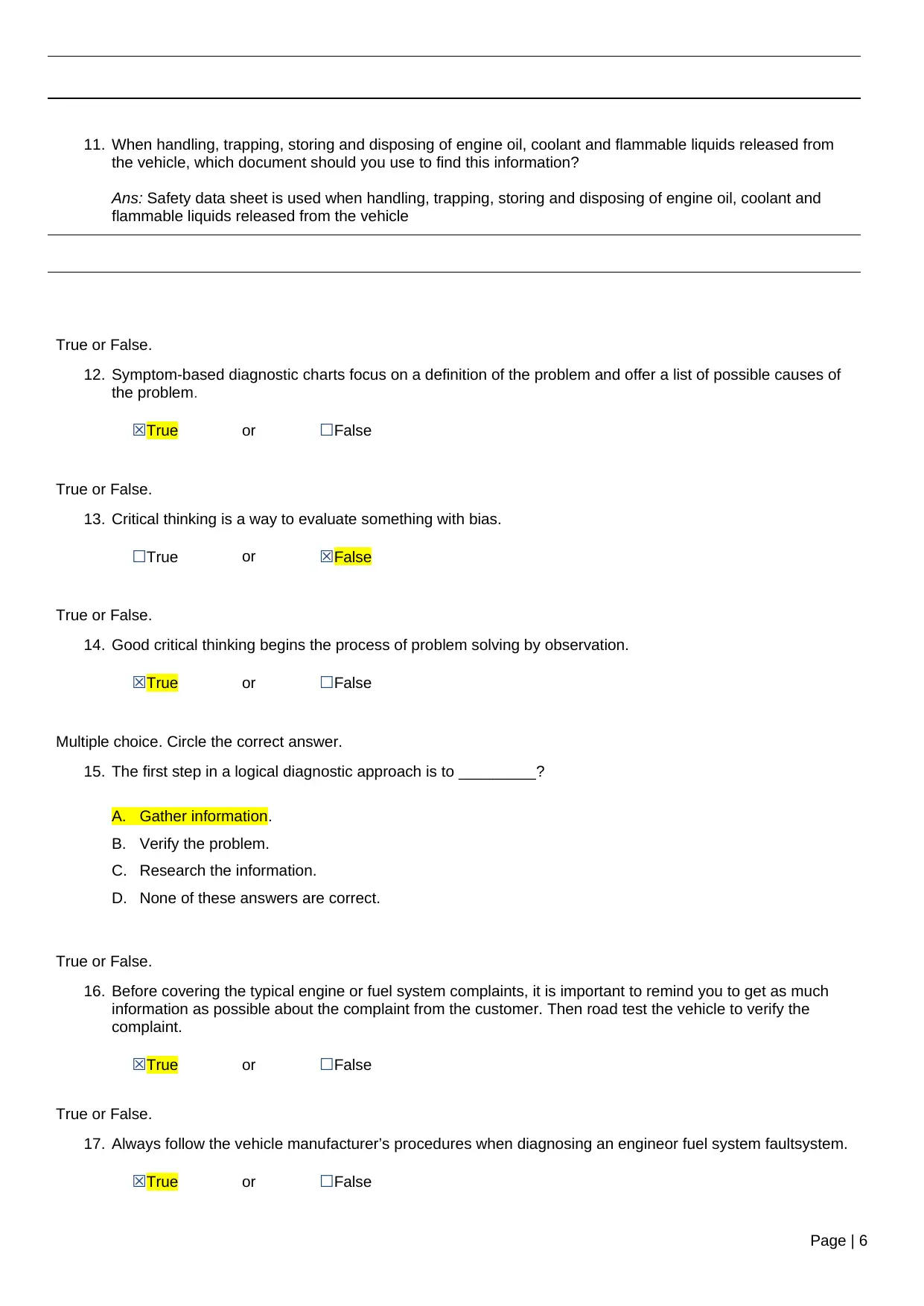
11. When handling, trapping, storing and disposing of engine oil, coolant and flammable liquids released from
the vehicle, which document should you use to find this information?
Ans: Safety data sheet is used when handling, trapping, storing and disposing of engine oil, coolant and
flammable liquids released from the vehicle
True or False.
12. Symptom-based diagnostic charts focus on a definition of the problem and offer a list of possible causes of
the problem.
☒True or ☐False
True or False.
13. Critical thinking is a way to evaluate something with bias.
☐True or ☒False
True or False.
14. Good critical thinking begins the process of problem solving by observation.
☒True or ☐False
Multiple choice. Circle the correct answer.
15. The first step in a logical diagnostic approach is to _________?
A. Gather information.
B. Verify the problem.
C. Research the information.
D. None of these answers are correct.
True or False.
16. Before covering the typical engine or fuel system complaints, it is important to remind you to get as much
information as possible about the complaint from the customer. Then road test the vehicle to verify the
complaint.
☒True or ☐False
True or False.
17. Always follow the vehicle manufacturer’s procedures when diagnosing an engineor fuel system faultsystem.
☒True or ☐False
Page | 6
the vehicle, which document should you use to find this information?
Ans: Safety data sheet is used when handling, trapping, storing and disposing of engine oil, coolant and
flammable liquids released from the vehicle
True or False.
12. Symptom-based diagnostic charts focus on a definition of the problem and offer a list of possible causes of
the problem.
☒True or ☐False
True or False.
13. Critical thinking is a way to evaluate something with bias.
☐True or ☒False
True or False.
14. Good critical thinking begins the process of problem solving by observation.
☒True or ☐False
Multiple choice. Circle the correct answer.
15. The first step in a logical diagnostic approach is to _________?
A. Gather information.
B. Verify the problem.
C. Research the information.
D. None of these answers are correct.
True or False.
16. Before covering the typical engine or fuel system complaints, it is important to remind you to get as much
information as possible about the complaint from the customer. Then road test the vehicle to verify the
complaint.
☒True or ☐False
True or False.
17. Always follow the vehicle manufacturer’s procedures when diagnosing an engineor fuel system faultsystem.
☒True or ☐False
Page | 6
⊘ This is a preview!⊘
Do you want full access?
Subscribe today to unlock all pages.

Trusted by 1+ million students worldwide
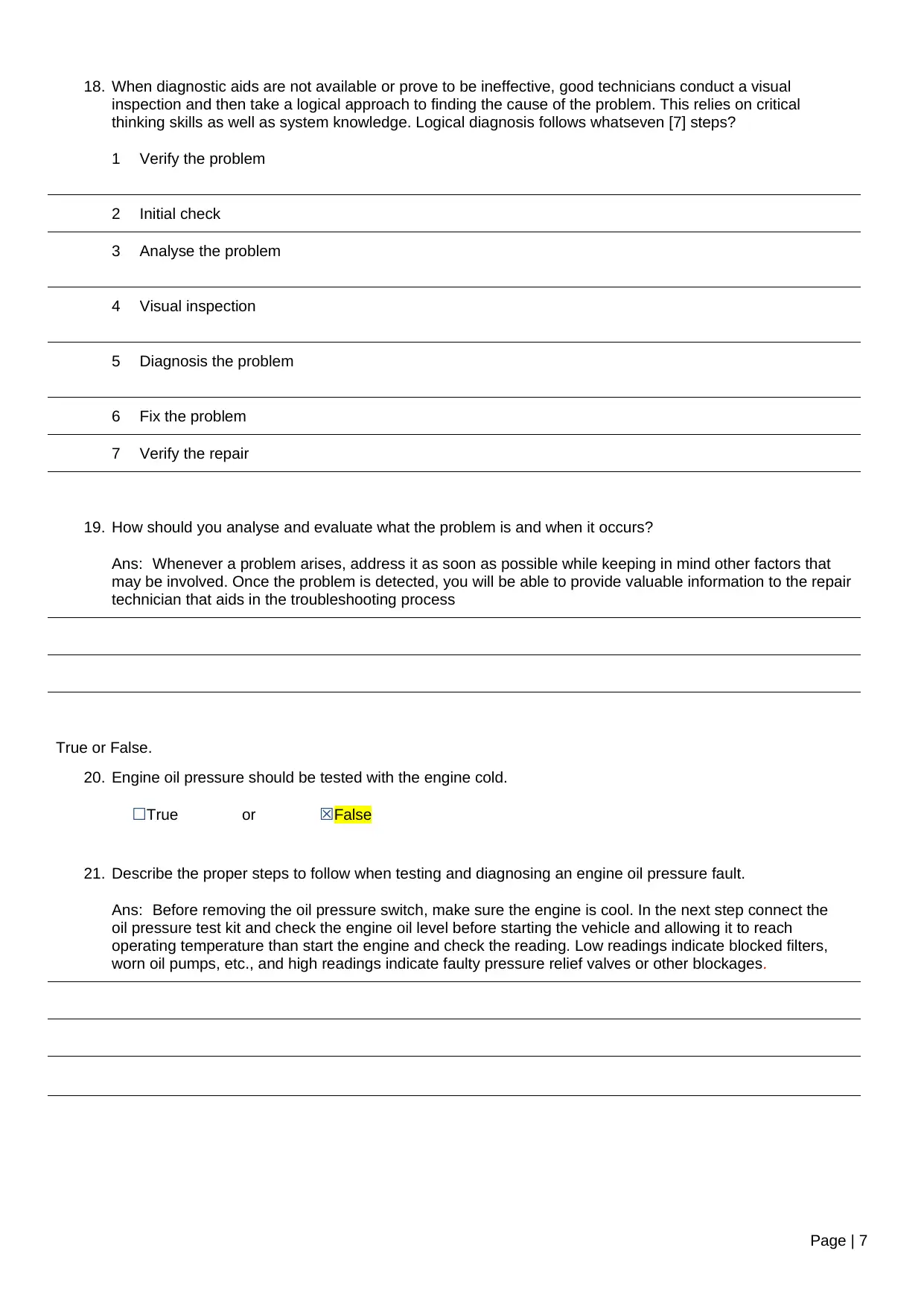
18. When diagnostic aids are not available or prove to be ineffective, good technicians conduct a visual
inspection and then take a logical approach to finding the cause of the problem. This relies on critical
thinking skills as well as system knowledge. Logical diagnosis follows whatseven [7] steps?
1 Verify the problem
2 Initial check
3 Analyse the problem
4 Visual inspection
5 Diagnosis the problem
6 Fix the problem
7 Verify the repair
19. How should you analyse and evaluate what the problem is and when it occurs?
Ans: “Whenever a problem arises, address it as soon as possible while keeping in mind other factors that
may be involved. Once the problem is detected, you will be able to provide valuable information to the repair
technician that aids in the troubleshooting process”
True or False.
20. Engine oil pressure should be tested with the engine cold.
☐True or ☒False
21. Describe the proper steps to follow when testing and diagnosing an engine oil pressure fault.
Ans: “Before removing the oil pressure switch, make sure the engine is cool. In the next step connect the
oil pressure test kit and check the engine oil level before starting the vehicle and allowing it to reach
operating temperature than start the engine and check the reading. Low readings indicate blocked filters,
worn oil pumps, etc., and high readings indicate faulty pressure relief valves or other blockages.”
Page | 7
inspection and then take a logical approach to finding the cause of the problem. This relies on critical
thinking skills as well as system knowledge. Logical diagnosis follows whatseven [7] steps?
1 Verify the problem
2 Initial check
3 Analyse the problem
4 Visual inspection
5 Diagnosis the problem
6 Fix the problem
7 Verify the repair
19. How should you analyse and evaluate what the problem is and when it occurs?
Ans: “Whenever a problem arises, address it as soon as possible while keeping in mind other factors that
may be involved. Once the problem is detected, you will be able to provide valuable information to the repair
technician that aids in the troubleshooting process”
True or False.
20. Engine oil pressure should be tested with the engine cold.
☐True or ☒False
21. Describe the proper steps to follow when testing and diagnosing an engine oil pressure fault.
Ans: “Before removing the oil pressure switch, make sure the engine is cool. In the next step connect the
oil pressure test kit and check the engine oil level before starting the vehicle and allowing it to reach
operating temperature than start the engine and check the reading. Low readings indicate blocked filters,
worn oil pumps, etc., and high readings indicate faulty pressure relief valves or other blockages.”
Page | 7
Paraphrase This Document
Need a fresh take? Get an instant paraphrase of this document with our AI Paraphraser
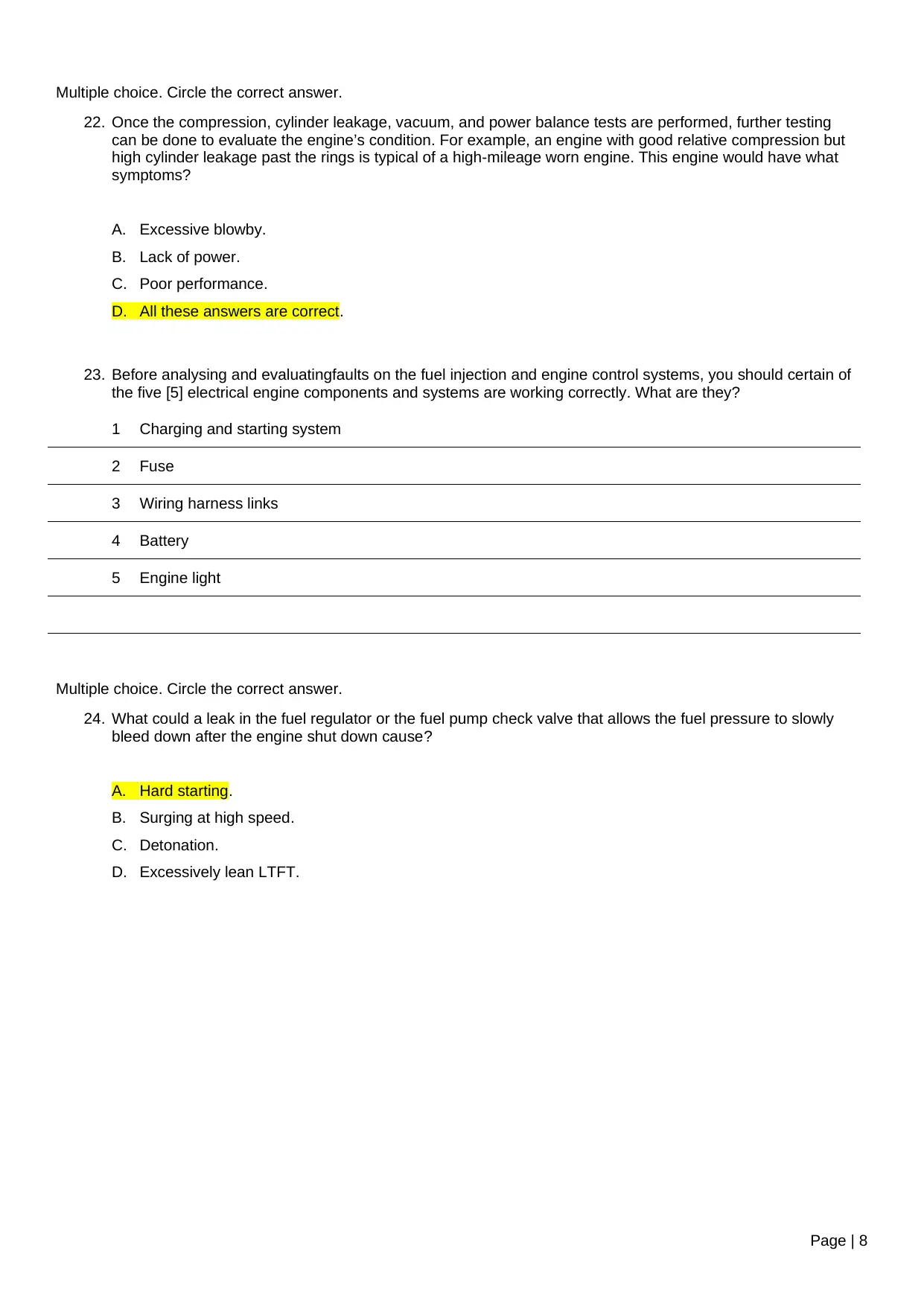
Multiple choice. Circle the correct answer.
22. Once the compression, cylinder leakage, vacuum, and power balance tests are performed, further testing
can be done to evaluate the engine’s condition. For example, an engine with good relative compression but
high cylinder leakage past the rings is typical of a high-mileage worn engine. This engine would have what
symptoms?
A. Excessive blowby.
B. Lack of power.
C. Poor performance.
D. All these answers are correct.
23. Before analysing and evaluatingfaults on the fuel injection and engine control systems, you should certain of
the five [5] electrical engine components and systems are working correctly. What are they?
1 Charging and starting system
2 Fuse
3 Wiring harness links
4 Battery
5 Engine light
Multiple choice. Circle the correct answer.
24. What could a leak in the fuel regulator or the fuel pump check valve that allows the fuel pressure to slowly
bleed down after the engine shut down cause?
A. Hard starting.
B. Surging at high speed.
C. Detonation.
D. Excessively lean LTFT.
Page | 8
22. Once the compression, cylinder leakage, vacuum, and power balance tests are performed, further testing
can be done to evaluate the engine’s condition. For example, an engine with good relative compression but
high cylinder leakage past the rings is typical of a high-mileage worn engine. This engine would have what
symptoms?
A. Excessive blowby.
B. Lack of power.
C. Poor performance.
D. All these answers are correct.
23. Before analysing and evaluatingfaults on the fuel injection and engine control systems, you should certain of
the five [5] electrical engine components and systems are working correctly. What are they?
1 Charging and starting system
2 Fuse
3 Wiring harness links
4 Battery
5 Engine light
Multiple choice. Circle the correct answer.
24. What could a leak in the fuel regulator or the fuel pump check valve that allows the fuel pressure to slowly
bleed down after the engine shut down cause?
A. Hard starting.
B. Surging at high speed.
C. Detonation.
D. Excessively lean LTFT.
Page | 8
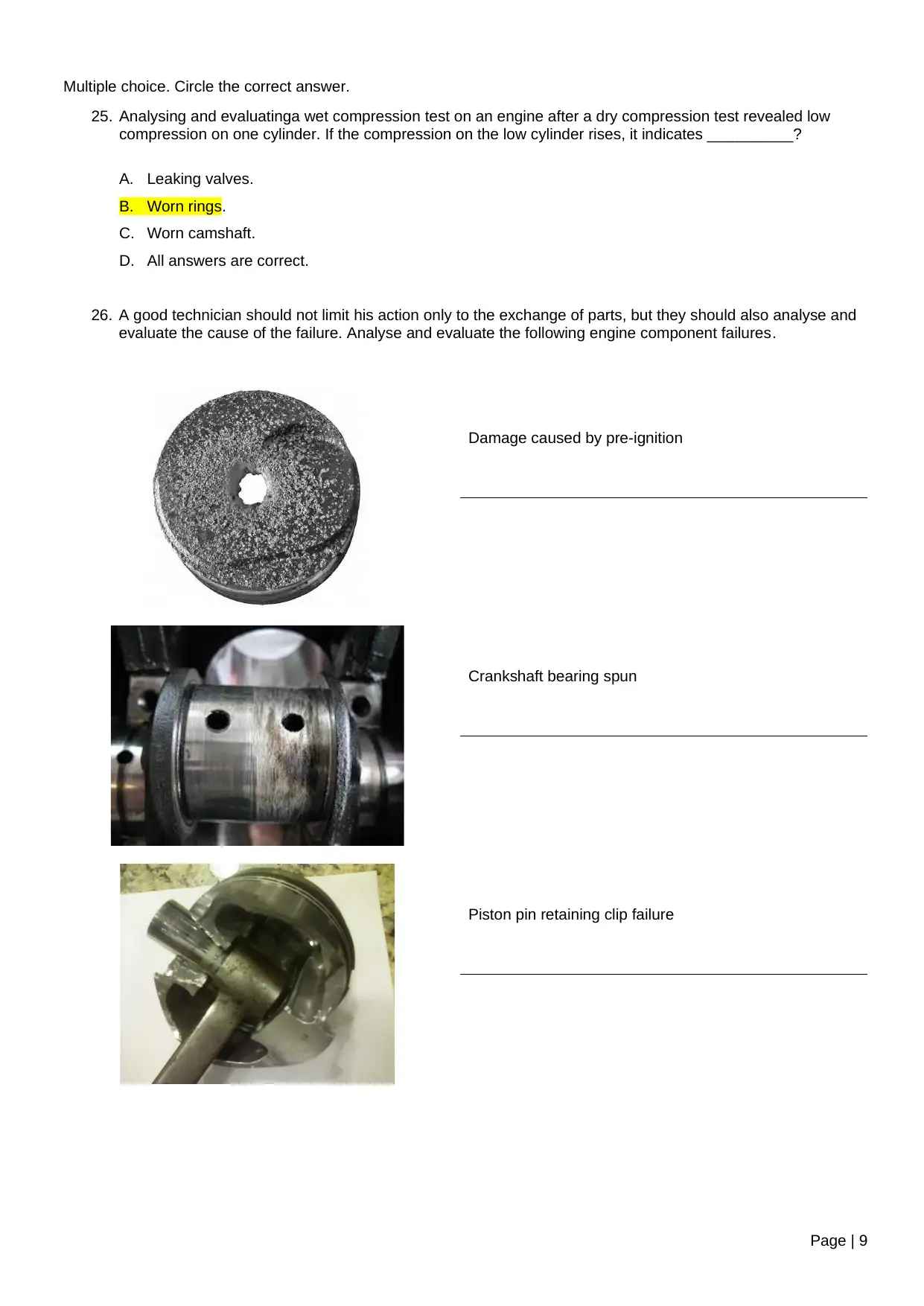
Multiple choice. Circle the correct answer.
25. Analysing and evaluatinga wet compression test on an engine after a dry compression test revealed low
compression on one cylinder. If the compression on the low cylinder rises, it indicates __________?
A. Leaking valves.
B. Worn rings.
C. Worn camshaft.
D. All answers are correct.
26. A good technician should not limit his action only to the exchange of parts, but they should also analyse and
evaluate the cause of the failure. Analyse and evaluate the following engine component failures.
Damage caused by pre-ignition
Crankshaft bearing spun
Piston pin retaining clip failure
Page | 9
25. Analysing and evaluatinga wet compression test on an engine after a dry compression test revealed low
compression on one cylinder. If the compression on the low cylinder rises, it indicates __________?
A. Leaking valves.
B. Worn rings.
C. Worn camshaft.
D. All answers are correct.
26. A good technician should not limit his action only to the exchange of parts, but they should also analyse and
evaluate the cause of the failure. Analyse and evaluate the following engine component failures.
Damage caused by pre-ignition
Crankshaft bearing spun
Piston pin retaining clip failure
Page | 9
⊘ This is a preview!⊘
Do you want full access?
Subscribe today to unlock all pages.

Trusted by 1+ million students worldwide
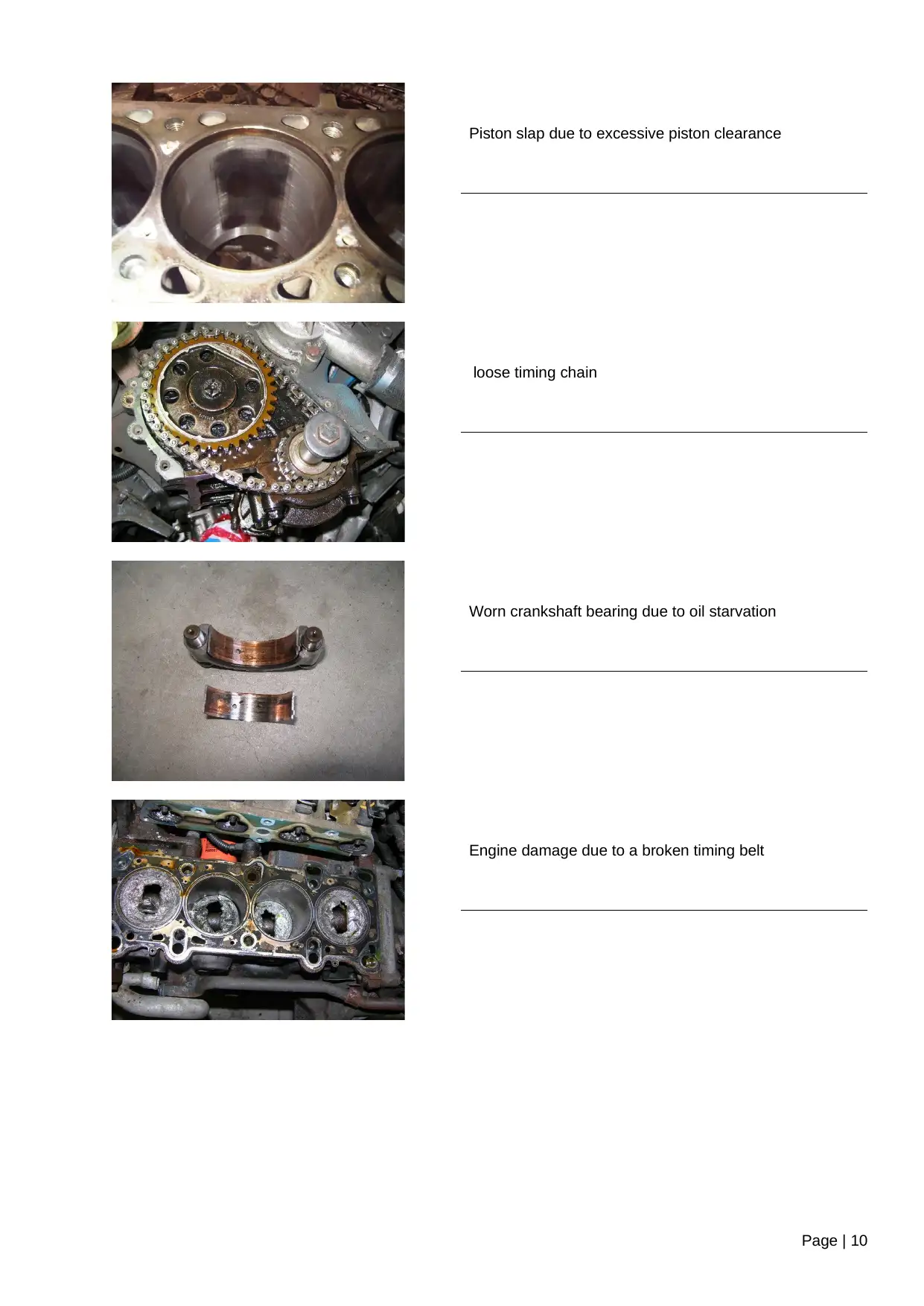
Piston slap due to excessive piston clearance
loose timing chain
Worn crankshaft bearing due to oil starvation
Engine damage due to a broken timing belt
Page | 10
loose timing chain
Worn crankshaft bearing due to oil starvation
Engine damage due to a broken timing belt
Page | 10
Paraphrase This Document
Need a fresh take? Get an instant paraphrase of this document with our AI Paraphraser
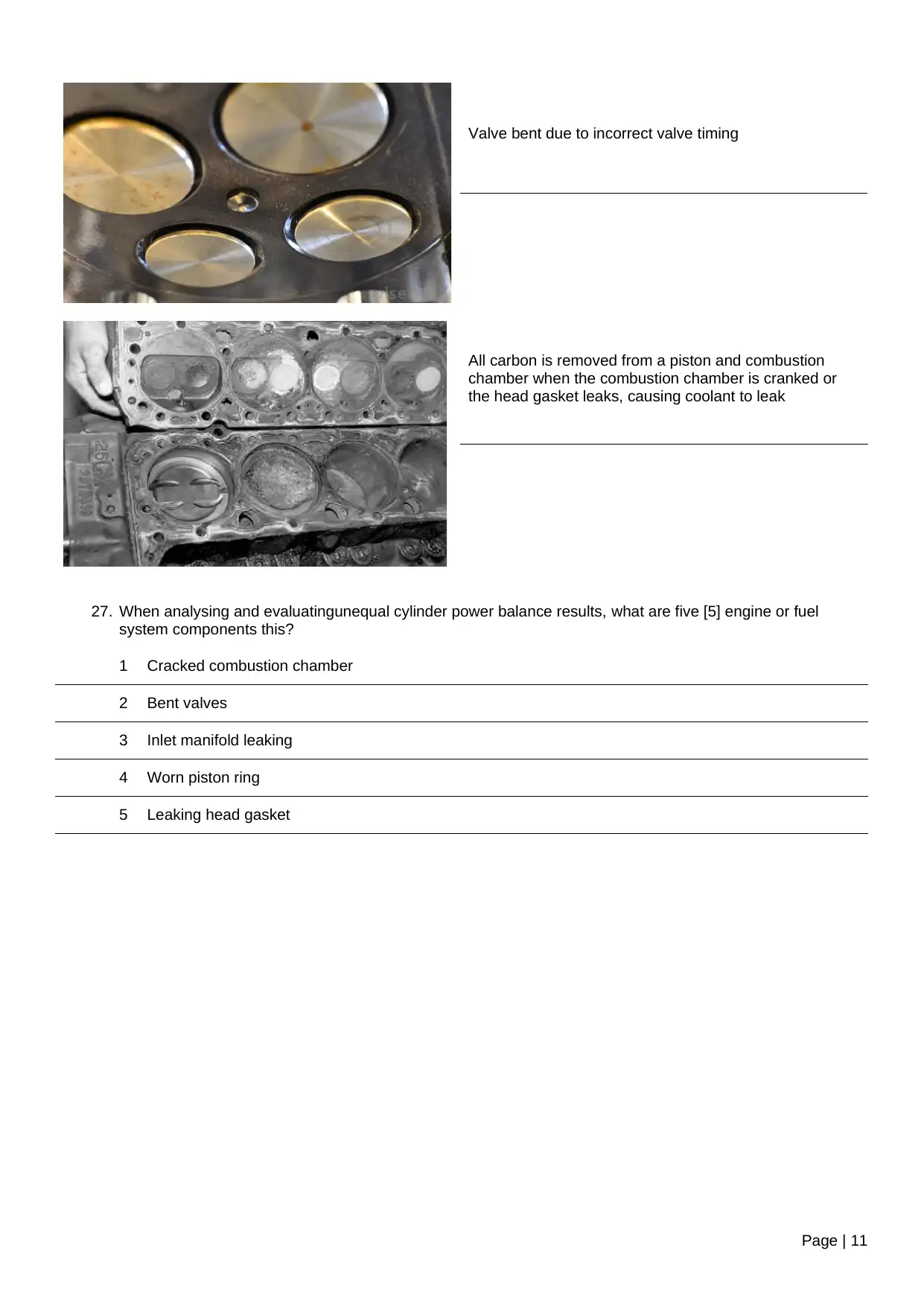
Valve bent due to incorrect valve timing
All carbon is removed from a piston and combustion
chamber when the combustion chamber is cranked or
the head gasket leaks, causing coolant to leak
27. When analysing and evaluatingunequal cylinder power balance results, what are five [5] engine or fuel
system components this?
1 Cracked combustion chamber
2 Bent valves
3 Inlet manifold leaking
4 Worn piston ring
5 Leaking head gasket
Page | 11
All carbon is removed from a piston and combustion
chamber when the combustion chamber is cranked or
the head gasket leaks, causing coolant to leak
27. When analysing and evaluatingunequal cylinder power balance results, what are five [5] engine or fuel
system components this?
1 Cracked combustion chamber
2 Bent valves
3 Inlet manifold leaking
4 Worn piston ring
5 Leaking head gasket
Page | 11
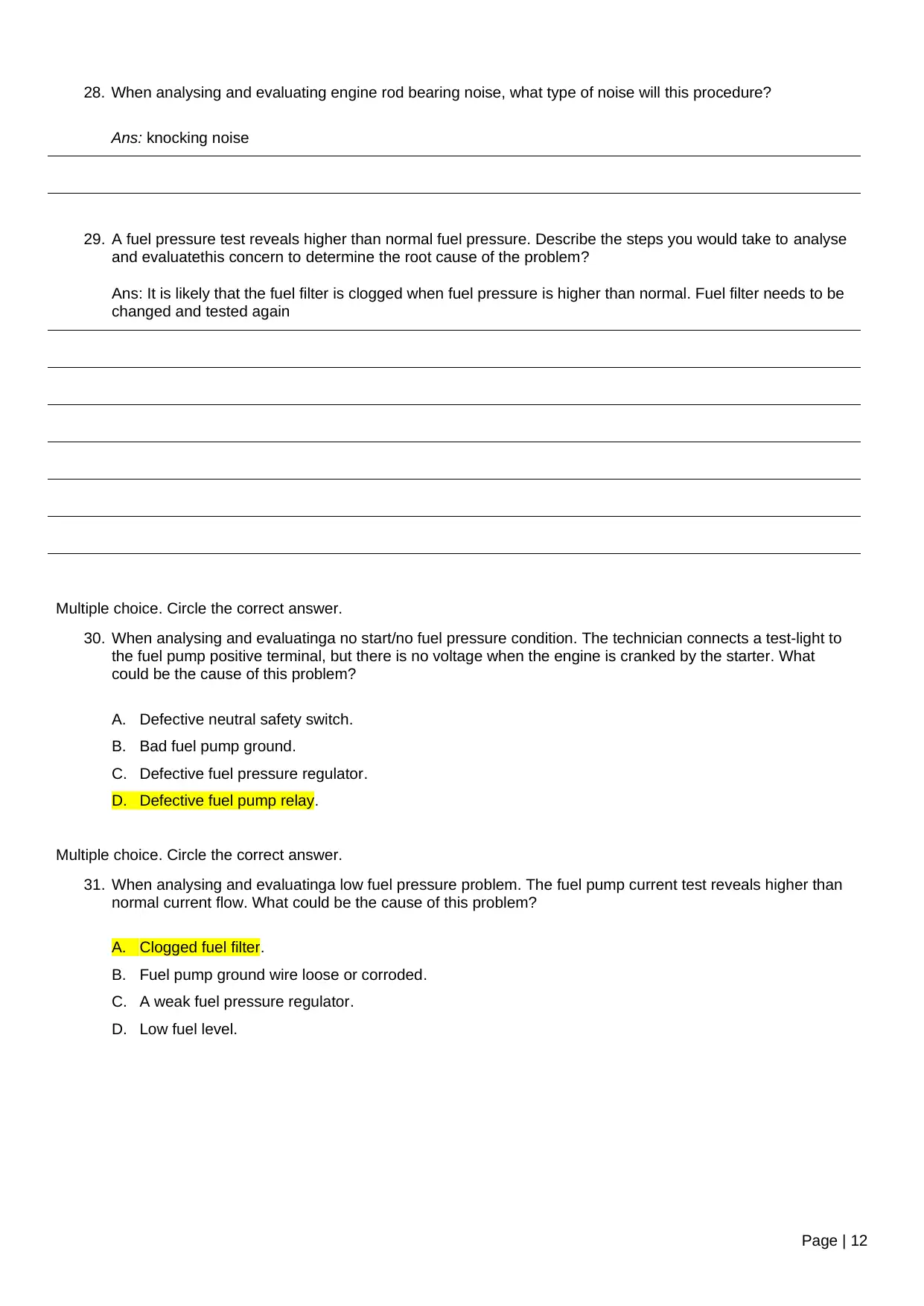
28. When analysing and evaluating engine rod bearing noise, what type of noise will this procedure?
Ans: knocking noise
29. A fuel pressure test reveals higher than normal fuel pressure. Describe the steps you would take to analyse
and evaluatethis concern to determine the root cause of the problem?
Ans: It is likely that the fuel filter is clogged when fuel pressure is higher than normal. Fuel filter needs to be
changed and tested again
Multiple choice. Circle the correct answer.
30. When analysing and evaluatinga no start/no fuel pressure condition. The technician connects a test-light to
the fuel pump positive terminal, but there is no voltage when the engine is cranked by the starter. What
could be the cause of this problem?
A. Defective neutral safety switch.
B. Bad fuel pump ground.
C. Defective fuel pressure regulator.
D. Defective fuel pump relay.
Multiple choice. Circle the correct answer.
31. When analysing and evaluatinga low fuel pressure problem. The fuel pump current test reveals higher than
normal current flow. What could be the cause of this problem?
A. Clogged fuel filter.
B. Fuel pump ground wire loose or corroded.
C. A weak fuel pressure regulator.
D. Low fuel level.
Page | 12
Ans: knocking noise
29. A fuel pressure test reveals higher than normal fuel pressure. Describe the steps you would take to analyse
and evaluatethis concern to determine the root cause of the problem?
Ans: It is likely that the fuel filter is clogged when fuel pressure is higher than normal. Fuel filter needs to be
changed and tested again
Multiple choice. Circle the correct answer.
30. When analysing and evaluatinga no start/no fuel pressure condition. The technician connects a test-light to
the fuel pump positive terminal, but there is no voltage when the engine is cranked by the starter. What
could be the cause of this problem?
A. Defective neutral safety switch.
B. Bad fuel pump ground.
C. Defective fuel pressure regulator.
D. Defective fuel pump relay.
Multiple choice. Circle the correct answer.
31. When analysing and evaluatinga low fuel pressure problem. The fuel pump current test reveals higher than
normal current flow. What could be the cause of this problem?
A. Clogged fuel filter.
B. Fuel pump ground wire loose or corroded.
C. A weak fuel pressure regulator.
D. Low fuel level.
Page | 12
⊘ This is a preview!⊘
Do you want full access?
Subscribe today to unlock all pages.

Trusted by 1+ million students worldwide
1 out of 22
Related Documents
Your All-in-One AI-Powered Toolkit for Academic Success.
+13062052269
info@desklib.com
Available 24*7 on WhatsApp / Email
![[object Object]](/_next/static/media/star-bottom.7253800d.svg)
Unlock your academic potential
Copyright © 2020–2025 A2Z Services. All Rights Reserved. Developed and managed by ZUCOL.





